You are here
Origin of World’s Largest Migrant Population, India Seeks to Leverage Immigration

A tuk tuk driver in India. (Photo: © ILO / Marcel Crozet)
As the world’s largest origin for international migrants, India has a rich history of immigration and emigration. The massive India diaspora, which can be found across the globe, includes millions of descendants of migrants and has taken shape mostly since the start of the colonial era, when large numbers of Indians were forcibly relocated to work on plantations and construction projects. The 1833 abolition of slavery in most parts of the British Empire transformed the colonial system, replacing slavery with indentured servitude. In the eight decades that followed, the United Kingdom relocated millions of bonded Indian workers to colonies across Africa, Asia, and the Caribbean. Later, India’s 1947 partition with Pakistan prompted the movement of millions of migrants throughout South Asia, in a vast reshuffling carried out along religious, ethnic, and other lines. India’s relationship with its neighbors has defined many aspects of its migration trends and foreign policy in the decades since.
More recently, the Middle East and Western countries have been top destinations for Indians abroad. Slightly more than half of India’s 17.9 million emigrants in 2020 lived in Persian Gulf countries, with nearly 3.5 million in the United Arab Emirates alone. Many have moved abroad for employment purposes; India is a significant source for low- and semi-skilled workers, as well as professionals in the health-care and science, technology, engineering, and math (STEM) fields.
There are vast economic differences within India, which is the world’s second most populous country with approximately 1.4 billion residents. Laborers who travel abroad can see their salaries increase by multiples, particularly since more than 90 percent of India’s workforce is engaged in the informal market. The states of Uttar Pradesh, Bihar, Tamil Nadu, and Kerala are the major sources of Indian emigration. Migration from the northern and highly populated Uttar Pradesh and Bihar is largely made up of semi-skilled and unskilled laborers, whereas migrants from southern Kerala and Tamil Nadu tend to have higher levels of education. Work-related emigration is largely dominated by men, and approximately 90 percent of migrant workers as of 2018 headed to the Persian Gulf or Southeast Asia, according to government figures, mostly in low- or semi-skilled professions.
Figure 1. Map of Major Migrant-Origin States in India
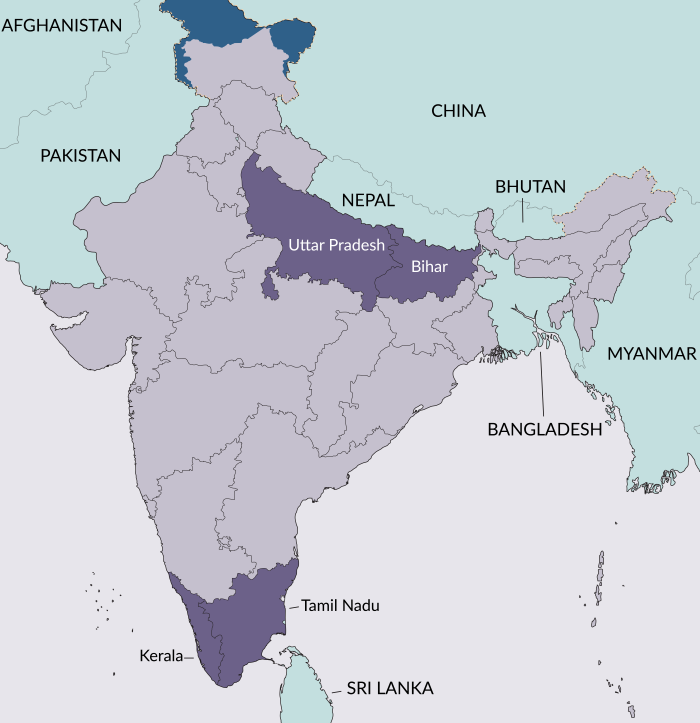
Source: MPI artist rendering.
Over time, the Indian government has built multiple systems for engaging with its emigrant population and the many descendants who call India their ancestral home. Money sent as remittances represents a prime tactic for improving financial conditions and diversifying risk, particularly in rural households. The estimated U.S. $87 billion in official remittances received in India in 2021 represented the world’s largest such flow and amounted to nearly 15 percent of all global transfers to low- and middle-income countries, according to the World Bank. India has also sought to capitalize on the skills and training well-educated workers acquire abroad, including by easing the path for them and their descendants to return to India or otherwise invest in its development. As an example, many college-educated emigrants who gained experience in Silicon Valley and other tech hubs subsequently used their ties to create a thriving information technology sector in Bangalore.
However, many Indians with low levels of education have repeatedly been targeted by deceptive or abusive foreign employers, particularly in the Middle East. This situation has prompted government efforts to protect Indians employed abroad, including by trying to certify recruitment agents.
India is also a significant country of immigration, with nearly 4.9 million foreign-born residents in 2020, mostly from elsewhere in South Asia. Immigration has been trending downward in recent years, but it continues to play a prominent role in national political debates and has stirred tensions with neighboring Bangladesh.
This country profile provides an overview of international migration from and to India, including developments during the colonial era and more recent government policies and initiatives. Indian migrants have played prominent roles in destination countries across the world and are an important asset for their native country, in which they have invested significant amounts of money and other resources.
Historical Overview of International Migration from India
India’s status as the world’s largest migrant-origin country is despite the presence of caste barriers, extended family arrangements, traditional values, low nationwide levels of education, and the predominance of semi-feudal relationships—all of which might suggest a disinclination towards international mobility. The country’s migration patterns are rooted in the British colonial era, which lasted until independence and partition with Pakistan in 1947. There are three major periods of emigration in this history that can be distinguished: emigration as the result of colonial design, including coercive movement of indentured laborers to other regions of the British empire; movement as the result of anti-colonial struggle and later the collapse of colonial rule; and more recent employment-driven migration, particularly to the Persian Gulf and wealthy Western countries.
Colonial Rule and Indentured Servitude
Beginning in the early 19th century, rapid colonial growth created a significant need for workers on plantations and for road, building, and railroad construction projects. The abolition of slavery in the United Kingdom in 1833 represented a watershed moment in the plantation industry that created incentives for large numbers of Indians and others to be brought throughout the empire. Subsequent abolition of slavery in France and Denmark (1848) and the Netherlands (1863) contributed to an immediate labor shortage in plantation agriculture, particularly sugar production, and a significant drop in agricultural output. Colonial powers demanded a new workforce structure and came to rely on indentured laborers from India and elsewhere.
Peasants from India and other territories who signed up to become indentured laborers were moved to colonies throughout the empire in a coercive process known as the coolie system. The similar kangani system of recruiting was used in Malaya and Ceylon, in which an Indian migrant known as a kangani (an anglicized version of the Tamil word kankani, which means overseer or foreman) was paid by colonial overseers to recruit other Indians, be their minder, and offer them advances that often became debts. The maistry system in Burma was similar in many ways, except that it involved a hierarchy of middlemen-employers. In contrast to indentured laborers, workers were legally free under these arrangements. Still, laborers typically found themselves in a sort of quasi-slave trade.
In 1838, British Guiana became the first Caribbean territory to which the empire forced Indian workers to migrate. Imperial leaders later followed suit by sending Indians to other territories in the Caribbean and elsewhere. Millions of Indians went to Mauritius during this time, and more than 500,000 indentured Indian workers were transferred to the Caribbean between 1838 and 1917 (see Table 1).
Table 1. Indian Indentured Laborers Brought to Select European Colonies, Various Years
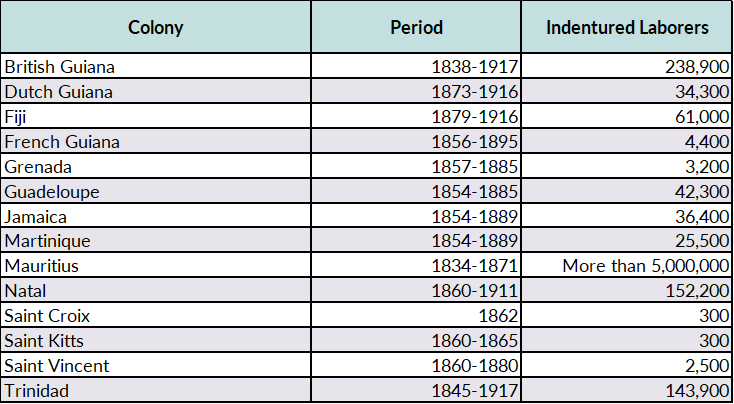
Sources: Kenneth L. Gillion and Kenneth Lowell Oliver Gillion, Fiji's Indian Migrants: A History to the End of Indenture in 1920 (London: Oxford University Press, 1962); S. Irudaya Rajan and Prabhat Kumar, “Historical Overview of International Migration,” in India Migration Report 2010: Governance and Labour Migration, ed. S. Irudaya Rajan (New Delhi: Routledge, 2010); G.W. Roberts and J. Byrne, “Summary Statistics on Indenture and Associated Migration Affecting the West Indies, 1834–1918,” Population Studies 20, no.1 (1966): 125-14; Hugh Tinker, The Banyan Tree: Overseas Emigrants from India, Pakistan, and Bangladesh (Oxford: Oxford University Press, 1977).
Indentured labor from India increased rapidly over time, due in part to colonialists’ initial perceptions that the laborers were adaptable to different agricultural conditions and had a hard-working nature. Although the system promised to provide them better economic opportunities, for most workers it turned out to be an exile into bondage, as they found one type of poverty simply replaced another.
Partition and Postwar Movement
The breakup of the British empire had dramatic consequences for India and other former colonies. At midnight on August 15, 1947, the territory that had previously been known as British India dissolved into the two self-governing dominions of India and Pakistan, prompting one of the world’s largest ever forced migrations. As many as 20 million people were displaced along religious lines as a result of the split, resulting in massive refugee movements as individuals, families, and communities trekked between the new countries. In the partitioned province of Punjab alone, 12 million people were displaced. This process of splitting and redrawing political boundaries was marked by horrific violence in large sections of northern India, particularly the Punjab region. Estimates vary, but as many as 1 million people were believed to have been killed and 50,000 women were abducted during the bloodshed.
In subsequent decades many Indians moved to the United Kingdom, especially from Punjab, following kinship and friendship ties. War-scarred Britain at the time was experiencing labor shortages, and as Commonwealth citizens, Indian nationals were able to move to the country without restriction. Migration to the United Kingdom became more difficult in subsequent years, as laws passed between 1962 and 1971 imposed new controls on movement from elsewhere in the Commonwealth. Still, as of 2020 India remained the largest country of birth for immigrants in the United Kingdom.
Labor Migration to the Middle East and West
The third wave of Indian emigration was primarily to the Gulf as a result of the region’s massive oil extraction and a construction boom beginning in the 1970s. Retail and construction trades such as carpentry, electrical wiring, and masonry have been popular for many migrants lacking postsecondary education, while those with higher levels of training have gone to sectors such as health care. Kerala, India's southernmost state, has accounted for most of the migration to the Middle East.
This third wave has also been comprised of doctors, engineers, financial professionals, and others heading to economically developed nations such as the United States. Worldwide, India has the highest number of emigrants with a postsecondary degree, with nearly 3.1 million residing in the 38 countries of the Organization for Economic Cooperation and Development (OECD) as of 2016. China (2 million) and the Philippines (1.8 million) are other top countries of origin for migrants with tertiary degrees; combined these countries are the origins for one-fifth of all OECD immigrants with a tertiary education. The number of highly educated Indian emigrants more than doubled between 2000 and 2010.
India is now a top origin country for immigrants in the United States, with new arrivals from India and China outpacing those from Mexico since 2013. This growth has been made possible by the revocation in 1965 of national-origins quotas that had guided U.S. immigration policy since the 1920s and discriminated against Asians and others not from northwestern Europe. The introduction of the H-1B visa for skilled workers in 1990 was also important; Indian immigrants are regularly the top recipients of these visas. Indian immigrants in the United States tend to be highly educated and have higher incomes than the overall foreign- and U.S.-born populations.
Table 2. Indian Immigrants by Country of Destination, 2020
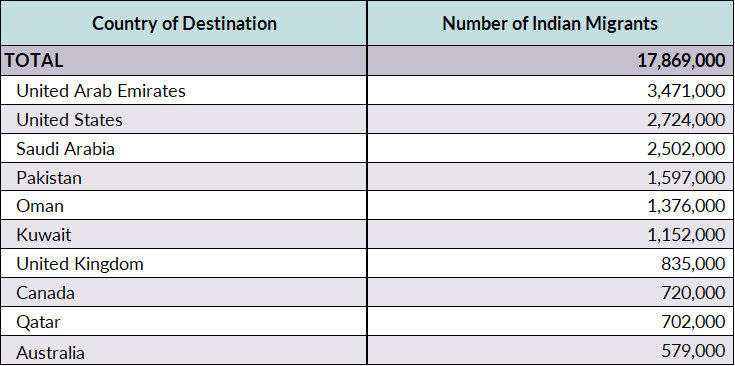
Source: United Nations, Department of Economic and Social Affairs (DESA), Population Division, “International Migrant Stock 2020: Destination and Origin, Table 1: International Migrant Stock at Mid-Year by Sex and by Region, Country or Area of Destination and Origin,” accessed February 4, 2022, available online.
Many Indians have also emigrated for study. Nearly 589,000 Indians studied abroad in 2019, according to the Ministry of External Affairs, with slightly less than one-third of them going to the United States. Significant numbers also have gone to Australia, Canada, and other countries. However, Indian international enrollment dropped to 261,000 in 2020, amid the start of the COVID-19 pandemic. Many international students from India come from urban areas, the upper and middle classes, and various castes, with backgrounds in economics, engineering, management, and medicine.
Engagement with Indians Abroad
High rates of emigration have prompted fears about “brain drain,” which the government has committed to stemming by encouraging students and non-resident Indians (NRIs) to return to the country. India also has made overtures to persons of Indian origin (PIOs), who are noncitizens of Indian descent; the Ministry of External Affairs said there were 13.1 million PIOs globally as of 2018. The government’s 2005 introduction of the Overseas Citizen of India (OCI) card permits former Indian citizens, their descendants, and citizens’ spouses to enjoy visa-free entry as well as other benefits such as a fast track to citizenship (people with links to Bangladesh and Pakistan are excluded from the scheme).
World-Topping Remittance Transfers
One reason for the government’s efforts to engage with Indian emigrants is the sizable sums of money that they and their descendants send back. Remittances to India have ballooned in recent years, and the estimated U.S. $87 billion received through formal channels in 2021—driven in part by support from the diaspora and others during the pandemic, as well as higher oil prices and economic recoveries in countries of destination—represented a more than sixfold increase over 2001 (see Figure 2). This is far more than any other country in absolute numbers and a full 64 percent higher than the $53 billion each to China and Mexico, the next largest remittance receivers. Still, remittances account for a relatively small 3 percent share of India’s overall economy.
Figure 2. Remittances to India, 1975-2021
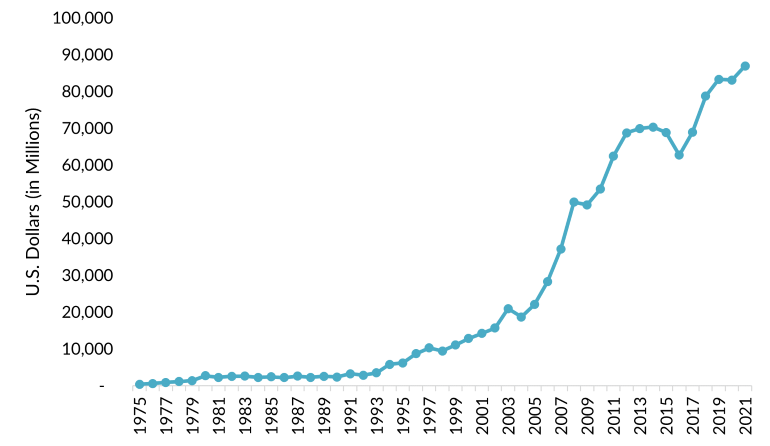
Note: Data for 2021 are projections as of November 2021.
Sources: Dilip Ratha et al., Migration and Development Brief 35: Recovery: COVID-19 Crisis through a Migration Lens, (Washington, DC: KNOMAD-World Bank, 2021), available online; World Bank Prospects Group, “Annual Remittances Data,” May 2021 update, available online.
In recent years, remittance transfers from the six Gulf Cooperation Council (GCC) countries—Bahrain, Kuwait, Oman, Qatar, Saudi Arabia, and the United Arab Emirates—have accounted for more than half of all funds remitted to India. The United States was the origin of nearly one-fifth of remittances to India in 2021.
The government has taken steps to encourage the inflow of remittances and other types of capital from the diaspora. Since the 1970s, NRIs have been able to keep money in special bank accounts in India, which have been an important source of the growth. At key moments in 1991, 1998, and 2000, the government also issued special bonds allowing NRIs and others to invest billions of dollars in the state. Economic liberalization since the 1990s has also played a role in the increasing remittance figures, as has the higher skill levels of recent emigrants.
Protection of Indians Abroad
In recent decades, reports have revealed the widespread exploitation of Indians working in low- and semi-skilled jobs in other countries. In some cases, migrants have had to pay exorbitant recruitment charges, been underpaid or had their wages withheld, and been forced to surrender their passports and other documents to their employers—situations which have been compared to being held hostage. All the while, migrant workers have been forced to endure long hours, abusive treatment, and other poor conditions.
These types of incidents have prompted the government to intervene on behalf of migrants’ welfare. Since adoption of the Emigration Act of 1983, some low-educated emigrant workers referred to as having Emigration Check Required (ECR) status, often including domestic workers and those in construction, have needed to obtain clearance from a government office before leaving the country, and foreign companies have needed to obtain certification before recruiting Indians. The law also attempts to cap service fees charged by recruiters. Emigration checks are only required for certain workers heading to specific countries primarily in the Middle East, which critics have said is part of a shortsighted focus that failed to consider how flows would diversify. Multiple lawsuits have also claimed that the government’s protections are ineffective, particularly with regards to the many recruitment agents who operate illegally.
Recently, the Ministry of External Affairs circulated draft legislation known as the Emigration Bill 2021, which would replace the 1983 law and alter the recruitment process for foreign work. It was designed to give the government more power and resources to engage with emigrants and serve as their watchdog, including through new a new bureaucratic structure. The new effort has faced criticism, however, for allowing migrant workers to face penalties, failing to limit workers’ fees for recruitment, and remaining silent on issues such as physical and sexual abuse faced by female migrants. Some advocates have instead pushed for a comprehensive rewrite of the law that would more explicitly resemble global ambitions such as those of the Sustainable Development Goals.
Immigration to India
India has for centuries been a popular destination for international migrants, with nearly 4.9 million foreign-born residents as of 2020, making it the 14th top destination country globally, although immigrants account for less than 0.4 percent of its 1.4 billion people. As far back as approximately 1500 BCE, nomadic pastoral Aryans from the Eurasian steppes arrived on the Indian subcontinent and territory inhabited by the native Dravidian people. They gradually spread across northern India, sometimes conquering existing populations and other times quietly assimilating, giving birth to the Vedic civilization. Empires including those of Alexander the Great, the Kushans of Central Asia, Muslim Sultans, Persians, the Portuguese, the Moghuls, and lastly the British governed land now known as India until its independence. Scholars, merchants, and other travelers also arrived through the centuries, seeking knowledge, wealth, and more.
Tens of thousands of British nationals and other Europeans moved to India in the 19th century under the umbrella of the East India Company, the British military, and a booming commercial trade. By 1901, nearly 170,000 Europeans were recorded as living in India, almost 61,000 of them soldiers (see Table 3). Many Europeans intended to remain in India only temporarily, with plans to leave after fulfilling military duties, earning sizable wealth, or accomplishing other pursuits. Anthropologist Bernard Cohn’s interest in the formation of empire as an intellectual and cultural phenomenon demonstrated how significant British innovations in India, such as tax and judicial systems, resulted in major structural changes in Indian social interactions.
Table 3. European Migrants in India, 1871-1901

Source: Peter J. Marshall, “British Immigration into India in the Nineteenth Century,” Itinerario 14, no.1 (1990): 25-44.
This flow changed following independence and partition with Pakistan. The great bulk of India’s immigrants now come from neighboring countries in South Asia, stemming from extended interpersonal and economic ties during colonial and pre-partition eras (see Table 4). Many immigrants have moved near commercial and agricultural centers, contributing to enormous urbanization that has come to define contemporary India, which is home to some of the largest cities in the world.
Table 4. Immigrants in India by Country of Origin, 2020
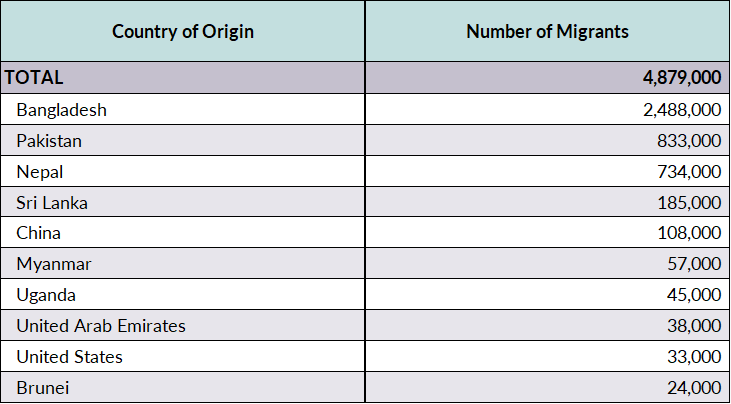
Source: United Nations DESA, Population Division, “International Migrant Stock 2020: Destination and Origin, Table 1: International Migrant Stock at Mid-Year by Sex and by Region, Country or Area of Destination and Origin,” accessed February 4, 2022.
The number of immigrants in India, who come primarily from Bangladesh, has declined significantly in recent decades, from nearly 7.6 million in 1990 to approximately 4.9 million in 2020, according to United Nations figures. One possible explanation is ballooning economic growth in Bangladesh, which at times has outpaced India’s and may dampen migration impulses. Bangladesh’s migration patterns also have diversified, with more nationals headed to the Middle East and other destinations.
Unauthorized Population and Issues of National Identity
A potentially very large number of immigrants live without legal status, with Bangladesh being the major source. Estimates vary and are not necessarily reliable, but the government in 2016 claimed that as many as 20 million Bangladeshis lived in India in irregular status, which would likely be the largest such population globally (the government has since acknowledged it did not have accurate data to back up this assertion). A registry of citizens in the northeast border state of Assam published in 2019, part of a process intended to identify unauthorized Bangladeshi immigrants, excluded 1.9 million people who could not adequately prove they had arrived in the state prior to Bangladesh’s 1971 split from Pakistan.
As in many countries with sizable unauthorized populations, India has seen significant political debate in recent years over irregular immigration. Some of these issues came to the fore with the controversial 2019 Citizenship Amendment Act (CAA), which makes faith a consideration for citizenship applications and grants a fast track to non-Muslim applicants from Afghanistan, Bangladesh, and Pakistan. The CAA was ostensibly designed to protect minority groups in these countries, but it was greeted with a chorus of protests and allegations that it was an attempt by the ruling Bharatiya Janata Party (BJP) to advance a Hindu nationalist vision of the country. India has no formal refugee system, although it was home to slightly more than 244,000 refugees and asylum seekers in 2020, mostly from Tibet and Sri Lanka. Researchers such as Stephen Croucher have highlighted the history of Muslim immigration in country, and how religious Hindus have tended to be threatened by and have less contact with Muslims.
What Next? Prospects of Plateauing Population and Changing Migrant Flows
India has long been a major source of emigrants, particularly migrant laborers. Whether as indentured workers in European colonies, builders in the Persian Gulf, or software coders in Silicon Valley, Indian migrants have had a significant impact on both their origin country and their places of destination. India’s world-topping receipt of remittances is notable, and the government has made efforts to safeguard its expatriate workers while also forging tighter bonds with them and the diaspora.
India has the world’s largest diaspora. With 17.9 million Indian-born people living abroad and 13.1 million who call India their ancestral home, the country must continue to consider the potential impact migration may have on its development and growth. Demographers project that India will overtake China to become the world’s most populous country in the next few years. However, findings of a major population survey released in 2021 showed that the country’s total fertility rate for the first time dipped slightly below replacement level, which could have implications for the government’s approach to emigrant workers and members of the diaspora. In addition, there are now 1,020 women for every 1,000 men in India—the first time that women have outnumbered men and the result of regulations aimed at reducing sex-selection practices and female infanticide, as well as women’s longer lifespans. The improving gender ratio demonstrates the success of women's empowerment policies in country a country with longstanding and strong son preference.
Meanwhile, the characteristics of Indian emigration are changing, reflecting divisions within the country. Southern states such as Kerala and Tamil Nadu have been traditional sources of migrant workers to the Middle East and Southeast Asia, leaving on ECR passports requiring prior government authorization. However, northern and less economically advanced states such as Uttar Pradesh and Bihar have in recent years overtaken their southern counterparts as the major origins of typically low-skilled, young men leaving for overseas work. The number of migrants from Kerala, where the fertility rate is even lower than for the country as a whole, declined from around 80,000 in 2011 to fewer than 25,000 in 2017.
As the world’s top migrant-origin country and home to several million immigrants, India is a major player in international migration. The recent circulation of a draft replacement to the Emigration Act of 1983 suggests that the government is interested in rethinking its role and modernizing the regulatory environment. One option would be to leave oversight in the hands of an independent market regulator and allow the private sector to provide market-driven services. Efforts to combat irregular migration will also be important, as will increased regular pathways for skilled workers to find employment abroad, particularly in target countries where labor may be required for years to come.
Among India’s biggest challenge is figuring out how to translate its demographic transformation into economic opportunity, for Indian residents as well as emigrants and members of the diaspora. As a rapidly developing economic power with a relatively young population, India plays a crucial role in international labor markets and foreign-worker schemes. History shows that it has filled this position for more than a century; even as the country changes, Indian migrants will likely continue to work abroad for years to come.
Sources:
Audebert, Cédric and Mohamed Kamel Doraï, eds. 2012. Migration in a Globalized World: New Research Issues and Prospects. Amsterdam: Amsterdam University Press. Available online.
Bates, Crispin, ed. 2003. Community, Empire and Migration: South Asians in Diaspora. Hyderabad: Orient Blackswan.
Becker, Judith. 1967. The Migration of the Arched Harp from India to Burma. The Galpin Society Journal 20: 17-23. Available online.
Bhagat, Ram B. 2014. World Migration Report 2014: Urban Migration Trends, Challenges and Opportunities in India. N.p.: International Organization for Migration. Available online.
Brain, J.P. 1985. Indentured and Free Indians in the Economy of Colonial Natal. In Enterprise and Exploitation in a Victorian Colony: Aspects of the Economic and Social History of Colonial Natal, eds. Bill Guest and John M. Sellers. Pietermaritzburg, South Africa: University of Natal.
Campbell, Bruce M. S. 2000. Medieval Antecedents of English Agricultural Progress. Farnham, UK: Ashgate.
Cohn, Bernard S. 1996. Colonialism and Its Forms of Knowledge: The British in India. Princeton, NJ: Princeton University Press.
Croucher, Stephen M., Senna Juntunen, and Cheng Zeng. 2014. Muslim Immigration to India: The Influence of Religiosity on the Perception of Immigrant Threat. Journal of Communication & Religion 37 (2): 79-92.
D’Aiglepierre, Rohen et al. 2020. A Global Profile of Emigrants to OECD Countries: Younger and More Skilled Migrants from More Diverse Countries. Social, Employment and Migration Working Paper, No. 239, Organization for Economic Cooperation and Development (OECD), Paris, February 2020. Available online.
Davis, Kinglsey. 1951. The Population of India and Pakistan. Princeton, NJ: Princeton University Press.
Dobbs, Richard et al. 2012 The World at Work: Jobs, Pay, and Skills for 3.5 Billion People. Seoul: McKinsey Global Institute. Available online.
Gerbeau, Hubert. 1986. Engagees and Coolies on Réunion Island: Slavery’s Masks and Freedom’s Constraints. In Colonialism and Migration: Indentured Labour Before and After Slavery, ed. P.C. Emmer. Dordrecht, Netherlands: Springer.
Gillion, Kenneth L. and Kenneth Lowell Oliver Gillion. 1962. Fiji’s Indian Migrants: A History to the End of Indenture in 1920. London: Oxford University Press.
Goldin, Ian, Andrew Pitt, Benjamin Nabarro, and Kathleen Boyle. 2018. Migration and the Economy: Economic Realities, Social Impacts and Political Choices. Oxford: Citi GPS. Available online.
Indian Ministry of External Affairs. 2019. Question No.2885 Number of Overseas Indians Abroad. Media release, July 18, 2019. Available online.
Kale, Madhavi. 1995. Projecting Identities: Empire and Indentured Labor Migration from India to Trinidad and British Guiana, 1836–1885. In Nation and Migration: The Politics of Space in the South Asian Diaspora, ed. Narayana Jayaram. New Delhi: Sage Publications.
Kondapi, C. 1951. Indians Overseas, 1838–1949. New Delhi: Indian Council of World Affairs.
Khadria, Binod. 2001. Shifting Paradigms of Globalization: The Twenty‐First Century Transition Towards Generics in Skilled Migration from India. International migration 39 (5): 45-71.
---. 2006. India: Skilled Migration to Developed Countries, Labour Migration to the Gulf. Migración y desarrollo (7): 4-37. Available online.
Khadria, Binod and Perveen Kumar. 2015. Immigrants and Immigration in India: A Fresh Approach. Economic and Political Weekly, February 21, 2015. Available online.
Khadria, Binod, Perveen Kumar, Shantanu Sarkar, and Rashmi Sharma. 2008. International Migration Policy: Issues and Perspectives for India. Working Paper No.1, International Migration and Diaspora Studies Project, Zakir Husain Centre for Educational Studies School of Social Sciences, Jawaharlal Nehru University, New Delhi. Available online.
Mahmud, Tayyab. 1997. Migration, Identity & the Colonial Encounter. Oregon Law Review 76: 633-90. Available online,
Marshall, Peter J. 1990. British Immigration into India in the Nineteenth Century. Itinerario 14 (1): 25-44.
Munshi, Kaivan and Mark Rosenzweig. 2009. Why Is Mobility in India So Low? Social Insurance, Inequality, and Growth. Cambridge, MA: National Bureau of Economic Research. Available online.
Ray, Manashi. 2013. The Global Circulation of Skill and Capital—Pathways of Return Migration of Indian Entrepreneurs from the United States to India. In Diaspora Engagement and Development in South Asia, eds. Tan Tai Yong and Mohammad Mizanur Rahman. London: Palgrave Macmillan.
Rajan, S. Irudaya and Prabhat Kumar. 2010. Historical Overview of International Migration. In India Migration Report 2010: Governance and Labour Migration, ed. S. Irudaya Rajan. New Delhi: Routledge.
Ratha, Dilip et al. 2021. Migration and Development Brief 35: Recovery: COVID-19 Crisis through a Migration Lens. Washington, DC: KNOMAD-World Bank. Available online.
Roberts, G.W. and J. Byrne. 1966. Summary Statistics on Indenture and Associated Migration Affecting the West Indies, 1834–1918. Population Studies 20 (1): 125-14.
Sharma, Chetna. 2019. Citizenship Amendment Bill 2016: Continuities and Contestations with Special Reference to Politics in Assam, India. Asian Ethnicity 20 (4): 522-40.
Sharma, Varitka, Lopamudra Ray Saraswati, Susmita Das, and Avina Sarna. 2015. Migration in South Asia: A Review. New Delhi: Population Council. Available online.
Singh, Ruchi. 2018. Credit Constraints and Rural Migration: Evidence from Six Villages in Uttar Pradesh. Migration Letters 15 (3): 389-99.
Singh, Ruchi and Ibrahim Sirkeci. 2021. Editorial: Focus on Indian Migrations. Migration Letters 18 (3): 229-36. Available online.
Tinker, Hugh. 1977. The Banyan Tree: Overseas Emigrants from India, Pakistan, and Bangladesh. Oxford: Oxford University Press.
Tumbe, Chinmay. 2014. The Great Indian Migration Wave, 1870–2010, Persistence & Consequences. Discussion Paper, Yale University, New Haven, CT, November 2014. Available online.
---. 2015. Missing Men, Migration and Labour Markets: Evidence from India. The Indian Journal of Labour Economics 58 (2): 245-67.
Vertovec, Steven. 1995. Indian Indentured Migration to the Caribbean. In The Cambridge Survey of World Migration, ed. Robin Cohen. Cambridge, UK: Cambridge University Press.
Wadhwan, Neha. 2018. India Labour Migration Update 2018. New Delhi: International Labor Organization. Available online.
Weiner, Myron. 1978. Sons of the Soil: Migration and Ethic Conflict in India. Princeton, NJ: Princeton University Press.
World Bank Prospects Group. 2021. Annual Remittances Data, May 2021 update. Available online.
Zachariah, K.C., K.P. Kannan, and S. Irudaya Rajan, eds. 2002. Kerala's Gulf Connection: CDS Studies on International Labour Migration from Kerala State in India. Kerala, India: Centre for Development Studies.
Zachariah, K. C., B.A. Prakash, and S. Irudaya Rajan. 2003. The Impact of Immigration Policy on Indian Contract Migrants: The Case of the United Arab Emirates. International Migration 41 (4): 161-72.


